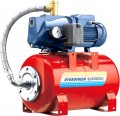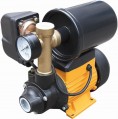Maximum performance
The maximum volume of water that the device can pump in a certain amount of time. It is one of the key specs of any pump because characterizes the volume of water with which the device can work. At the same time, it does not always make sense to pursue maximum performance — after all, it significantly affects the dimensions and weight of the unit.
Some formulas allow you to derive optimal performance values for different situations. So, if the pump is designed to supply water to water intake points, its minimum required performance should not be lower than the highest total flow rate; if desired, a margin of 20-30% can be added to this value. And for sewer models (see "Suitable for"), everything will depend on the volume of wastewater. More detailed recommendations for choosing a pump depending on performance can be found in special sources.
Maximum head
The maximum head generated by the pump. This parameter is most often indicated in meters, by the height of the water column that the unit can create — in other words, by the height to which it can supply water. You can estimate the pressure created by the pump using a simple formula: every 10 m of head corresponds to a pressure of 1 bar.
It is worth choosing a pump according to this parameter, taking into account the height to which it should supply water, as well as adjusting for losses and the need for pressure in the water supply. To do this, it is necessary to determine the difference in height between the water level and the highest point of water intake, add another 10 to 30 m to this figure (depending on the pressure that needs to be obtained in the water supply), and multiply the result by 1.1 — this will be the minimum pressure required.
Maximum particle size
The largest particle size that the pump can handle without problems. This size is the main indicator that determines the purpose of the device (see above); and in general, the larger it is, the more reliable the device, the lower the risk of damage if a foreign object enters the suction line. If the risk of the appearance of too large mechanical impurities is still high, additional protection can be provided with filters or grids at the inlet. However, such a measure should be considered only as a last resort, because from constant exposure to solid particles, the grids become clogged and deformed, which can lead to both clogging of the line and filter breakthrough.
Maximum liquid temperature
The highest temperature of water at which the pump is capable of operating normally. Usually, in most models this parameter is 35-40 °C — at high temperatures it is difficult to ensure effective cooling of the engine and moving parts, and in fact, such conditions are rare.
Dry run protection
A system that protects the unit from running without water.
The dry running mode is abnormal for any pump: at best, the mechanism of the unit in this mode experiences increased loads, and at worst, the device may fail and even a serious accident. This feature allows you to prevent such consequences. The specific method of protection against dry running may be different; one of the most popular options is a float switch (see below). However, in addition, flow sensors, pressure or level switches can be used. These details depend both on the general type of pump and on the specific model; they should be specified separately in each case.
Volume of water pressure tank
The volume of the water pressure tank provided in the design of the pressure tank unit.
A water pressure tank is a reservoir capable of holding a certain volume of water. It performs several functions at once. The main ones are: firstly, maintaining a stable pressure; secondly, protection against water hammer; and thirdly, storage of an “emergency” supply of water in case of a power outage, pump breakdown, etc. The larger the volume of this tank, the better it handles its capabilities; on the other hand, a large capacity significantly affects the dimensions and cost of the tank. Therefore, it does not always make sense to look for a pump with the maximum volume of the water pressure tank. Specific recommendations on choosing the optimal volume for different situations can be found in special sources.
Maximum power
Rated power of the pump motor. The more powerful the engine, the higher the performance of the unit, usually, the greater the pressure, suction height, etc. Of course, these parameters largely depend on other features (primarily the pump type, see above); but models similar in design can be compared in terms of power.
Note that high power, usually, increases the size, weight and cost of the pump, and also implies high costs of electricity or fuel (see "Power source"). Therefore, it is worth choosing a pump according to this parameter taking into account the specific situation; more detailed recommendations can be found in special sources.
Engine type
Type of motor installed in the electric pump (see "Power source").
— Asynchronous. The most common type of electric motor nowadays. Asynchronous motors are simple in design and inexpensive, while they are very reliable. Their main disadvantage is the difficulty in regulating the rotational speed and the dependence of this frequency on the load on the rotor; on the other hand, in most cases, these shortcomings are not critical.
— Synchronous. Without going into technical details, we can say that this type of electric motor is considered more advanced than asynchronous — in particular, due to the ability to adjust the speed easily. At the same time, such units are difficult to manufacture and expensive, so they are rare — mainly in high-end technology, where adjustment accuracy is a key parameter.
Country of origin
Country of origin of the brand under which the pump is marketed.
There are many stereotypes related to how the origin of goods from a particular country affects their quality. However, these stereotypes are unfounded. Firstly, this paragraph does not indicate the actual place of production of the unit, but the "homeland" of the trademark (or the location of the manufacturer's headquarters); production facilities may be located in another country. Secondly, the actual quality of the product depends not so much on geography, but on the organization of processes within a particular company. So when choosing, it is best to focus not so much on the "nationality" of the pump, but on the overall reputation of a particular brand. And paying attention to the country of origin makes sense if you fundamentally want (or do not want) to support a manufacturer from a certain state.

